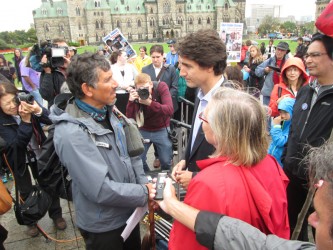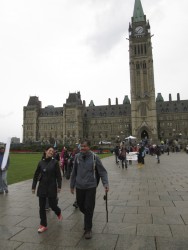Article Origin
Volume
Issue
Year
On a windy and rainy Saturday morning in early October, Dr. Stanley Vollant walked east along the paved trail that hugs the shoreline of the Ottawa River, heading toward Parliament Hill.
He had a message to share with the federal government and Indigenous people from across the country, but was taking the long way to get there.
Vollant, a surgeon from Pessamit, an Innu village on the north shore of the St. Lawrence River, about 600 kilometres northeast on Montreal, is nearing the home stretch of a six-year, 6,000-kilometre series of walks between Aboriginal communities throughout eastern Canada. His Innu Meshkenu (Innu road) project — multi-week trips, sometimes with several dozen participants — demonstrates the importance of resilience and perseverance; of reestablishing a connection to the land, to the past and to each other; of taking control of your life, one step at a time.
The fall 2014 leg of Vollant’s journey began near Temiscaming, on the Ontario-Quebec border, about 400 kilometres up the Ottawa River from the capital. Travelling on foot and, for the first time since the project began, in 26-foot-long rabaska canoes, 20 or so people with Anishinabeg, Atikamekw, Metis and Canadian ancestry made their way through Algonquin territory, with Vollant speaking to Aboriginal youth at schools and other stops.
The group was supposed to paddle into Ottawa, but was hit by strong winds and dangerous waves while attempting to cross Constance Bay, west of the city. Vollant thought about a deceased friend of his from medical school — John Big-Canoe, an Ojibwe doctor whose canoe capsized as he was paddling to visit patients off Manitoulin Island 20 years ago — and made a beeline for the shore. He and the others walked 35 kilometres into Ottawa instead. “We had life vests,” said Vollant, “but life vests in big water is not a fun experience.”
The next morning, after camping at a waterside park, Vollant set off to hike the final 11 kilometres to Parliament Hill. It was the National Day of Remembrance for Missing and Murdered Indigenous Women, and he was due on the steps of Centre Block to address the rally.
Although Vollant is well versed in both Aboriginal and mainstream politics, and is critical of the Harper government’s dysfunctional relationship with Canada’s First Nations and Inuit, he stresses that his project is not an act of protest.
“It’s an affirmative walk,” he said as ducks chattered in the shallows beside the trail. “It’s meant to empower people, to show that we should pursue our dreams and never give up. I’m trying to provide an example.”
In a sense, Innu Meshkenu began in Ottawa, and this day had brought Vollant full circle. He now lives in Montreal and makes a living doing locum surgeries throughout Quebec, but in 2008 he was living in the capital, working at a hospital and running the Aboriginal program at the University of Ottawa’s medical school.
Drained and depressed, Vollant went to Spain to walk the Camino de Santiago pilgrimage route that fall, and one night he had a vision: he saw himself walking in the forest with youth and Elders, following the routes and rhythms of his ancestors. He knew what he had to do.
Walking from reserve to reserve, wearing snowshoes and pulling his gear on a wooden toboggan during winter expeditions, sleeping in canvas prospector tents and eating meals of moose and salmon as often as possible, Vollant celebrates healthy activities and ancient traditions.
To him, the problems that plague many Aboriginal communities and the violence faced by many Aboriginal girls and women have the same root causes.
“The loss of so many Aboriginal women is just the tip of an iceberg, a much larger challenge — a lack of cultural, social, physical and economic health in our towns and villages,” he said. “Most of the women who were murdered or went missing were fleeing an environment that was unsafe for them. They were unprepared for big cities. They didn’t have the tools, the education, to deal with this world. They were easy prey. If we just deal with this problem at a police and justice level, we won’t solve this issue.
“If we want our kids to have dreams, and a chance to realize their dreams, they need a good education,” he continued, “and we have to invest the money and time and effort needed to create safe places where this can happen.”
Vollant believes that chiefs must be accountable for band finances, and that many leaders, especially in small communities, struggle to manage the complex and at times conflicting demands of elected office. But underlying these issues, he says, is a lack of funding for education. And he knows that all change, even if a new relationship with the federal government is essential, must start from within.
A small group was waiting for Vollant under a tent outside the Canadian War Museum, just shy of Parliament Hill. Ghislain Picard, interim national chief of the Assembly of First Nations, gave the doctor a hug. They’re cousins.
Picard, who grew up in Pessamit, is inspired by Vollant’s ability to balance conventional medicine with traditional knowledge, and his insistence that personal transformation is the path to societal change.
“He’s sensitive to the issue of murdered and missing women and girls,” Picard said about Vollant. “But at the same time, there’s also the issue of ourselves as individuals, and what he’s done over the last four years, on his walks, trying to get our people involved, shows that we need to be doing more in order to have a better understanding of the challenges we face.
“There are many things we need to reverse in order to address the social and economic conditions in our communities, including violence, and education is certainly key — as it is a key on our road to self-determination.
“Stan’s message, I think, is, ‘Let’s take on that challenge, but let’s not rush things.’ Obviously, self-determination is a collective goal, but at the same time, it needs the effort of everyone as individuals. No matter what position we’re in, no matter what we do for our communities, every step or action is important.”
Vollant and Picard led the Innu Meshkenu walkers to Parliament Hill, where other Aboriginal leaders, federal politicians, relatives of murdered and missing women, and about 400 supporters, were waiting for the vigil to begin.
“He is doing something deeply moving and powerful that inscribes itself into a long tradition, not just of Native activism but things that touch the breadth and scope of this land,” Liberal leader Justin Trudeau said about Vollant.
“Incremental change — within ourselves, within our community, within our country — happens by opening our hearts and our minds.”
- 2421 views


